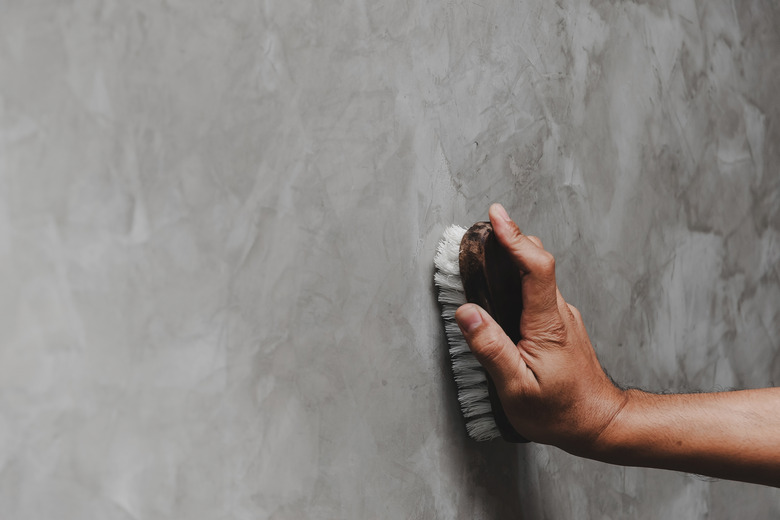How To Use Concrete Floor Sealer
A concrete floor needs a concrete sealer as much as a hardwood floor needs a wood finish — and maybe even more so. Concrete is such a porous material that spills can soak in deeply on an unsealed floor and be virtually impossible to remove. The sealer either soaks into the concrete or remains on the surface to prevent absorption of other liquids, and it also acts against efflorescence, which are mineral stains left by water seeping to the surface from underneath.
Sealing a concrete floor isn't difficult, but you can definitely do it wrong depending on the product you choose. While spraying is usually the most effective method, you can also do the job with a mop or roller, but be careful because a roller can leave marks when you use it to apply a surface coating. Each type of concrete sealer has its own application method, so it's always important to check the manufacturer's recommendations.
Types of Concrete Floor Sealers
Types of Concrete Floor Sealers
The type of concrete sealer you need depends on the characteristics of the surface of the concrete floor and the effect you want to achieve. A penetrating sealer soaks into the pores and provides waterproofing in the same way that an oil finish penetrates wood, but if the concrete is dyed or stained, a surface sealant that remains on the concrete surface is more appropriate. A list of common sealers includes:
Penetrating sealers
If you're sealing a garage floor, an outdoor patio, a driveway or any raw concrete surface that needs moisture and mildew protection and you don't want a high-gloss finish, use a penetrating sealer. Most products have silane, siloxane, silicate or siliconate formulations, and they leave a matte finish that does little to alter the look of the natural concrete while preventing moisture incursion and allowing residual moisture in the concrete to escape. Two of the brands recommended by Garage Tool Advisor include:
- PS101 from Concrete Sealers USA: Protects from freezing and thawing damage and deicing chemicals as well as scaling and spalling caused by moisture.
- DryWay 205 from Radon Seal: Primarily used for driveways, this sealer has very good resistance to direct sunlight and UV radiation and sheds rainwater easily.
Acrylics
The thinnest of the film sealers and the easiest to apply, acrylic sealers come in water-based and solvent-based formulations and are intended for interior and exterior applications, although you generally use a water-based product indoors. Sheen levels range from matte to full gloss, and because acrylic sealers don't alter the floor color, they are a good choice over a patterned stain or dye. Some top brands include:
- Cryli-Tek 5505: A solvent-based decorative sealer that leaves a full-gloss finish that looks great on patios and walkways.
- Armor WB25: A water-based acrylic sealer that leaves a high-gloss finish that is perfect for interior and exterior surfaces.
Polyurethanes and urethanes
Also a film coating, polyurethanes and urethanes are almost twice as thick as acrylics and offer a more robust, abrasion-resistant surface than acrylics can offer. They are more expensive than acrylics and come in water-based and solvent-based formulations and a range of sheen levels, and they are suitable for interior and exterior applications. Concrete Sealer Reviews recommends urethanes as the longest-lasting of all sealers but cautions against using them on driveways because they aren't breathable. They recommend:
- Urethane 645: A solvent-based product great for garage floors, carports and areas with high foot traffic. This product is noted for superior hardness, chemical resistance, abrasion resistance and UV resistance.
- Polyurethane 250: A two-part, solvent-based product that offers superior UV resistance and gloss retention. A low-VOC formulation is available for California residents.
Epoxies
Epoxy sealers offer the thickest, hardest seal coat available and also come in water-based and solvent-based formulations. Most are two-part products that must be mixed prior to application, and most impart a clear or opaque high-gloss finish. Popular products include:
- Epoxy 325: A water-based sealer, Epoxy 325 is often used as a primer for a urethane top coat because it bonds better to concrete.
- Euco #512 VOX Epoxy Sealer: This is also a water-based product that is resistant to gasoline and solvent spills and is also frequently used as an undercoating for a urethane product.
What Type of Concrete Sealer to Use
What Type of Concrete Sealer to Use
The best choice of sealer depends on the nature of your concrete floor, whether it is indoors or outdoors and whether the concrete already has a stain, dye or previous seal coat. Penetrating sealers are the easiest to apply, but they are designed mostly for outdoor use. However, a penetrating water-based sealer can work well as a basement concrete floor sealer because its matte finish doesn't change the color of the concrete — a major plus if you want a natural-looking concrete surface.
Film coatings are best for indoor use, and an acrylic one is generally the least expensive and easiest to apply. Solvent-based acrylic products last longer than water-based ones, but the high VOC content usually makes solvent-based sealers unsuitable for use indoors. Epoxy and polyurethane coatings form an extremely tough top coat and are preferred for indoor use, but application is trickier than for acrylic sealers, and they produce a glassy surface that can be slippery if you don't add an anti-slip additive.
If you choose an acrylic sealer for your concrete floor, expect to either fortify it periodically with wax or a top coat of some other finish or, at the very least, apply a refresher coat every few years. None of that will be necessary if you choose a polyurethane or epoxy sealer because both are more durable than acrylic, but because the finish these products leave is thicker and can yellow, it might change the color of the floor.
Getting Ready to Apply Concrete Sealer
Getting Ready to Apply Concrete Sealer
The application methods for penetrating and acrylic sealers are fairly straightforward, but that isn't necessarily true for epoxy or polyurethane sealers, especially if they come in two parts that you have to mix. No matter which product you use, you should always check the application directions on the container.
Be sure to check the weather and choose the right time for sealing. The optimum temperature for applying concrete sealers is between 50 and 80 degrees Fahrenheit. If the temperature is too warm, the solvent can evaporate too quickly, causing the sealer to form bubbles and crack, and if the temperature is too cold, the sealer may not dry and cure completely. If you're working outside, choose a dry day with humidity less than 85 percent and no rain in the forecast.
Preparing the Concrete
Preparing the Concrete
If the concrete is new, wait from 30 days to a month to allow it to fully cure before sealing it. If you're sealing existing concrete, check to see if it already has a sealer by pouring a small amount of water on it and noting what happens. If the water beads up and sits on the surface, the concrete most likely has been sealed. If the water readily soaks into the surface, the concrete likely has not been sealed, or it has an old sealer that has largely worn off.
If the floor was previously sealed, you have to remove the old sealer before applying a penetrating or acrylic sealer. Professionals often use a sandblaster for this, but DIYers are better off using a chemical stripper. Apply the stripper with a paint roller and scrape off the stripper/sealer with a long-handled scraper.
Sweep and vacuum all dirt from the concrete and then use a degreaser to remove oil spots and surface grime and a putty knife to scrape off residual mastic from any previous floor covering. Finally, wash the concrete with a solution of trisodium phosphate and water to etch the surface for better sealant adhesion. Rinse well with clean water and let the concrete dry for at least 24 hours.
Applying Penetrating and Acrylic Sealers
Applying Penetrating and Acrylic Sealers
The easiest way to apply thin sealers to concrete is to use a garden sprayer, which works especially well outdoors, but most pros use an airless sprayer. If you have a hand-held airless sprayer, you can use that, but you'll have to refill the cup several times for an average-size concrete slab. You can also pour the sealer directly on the floor and spread it with a mop or paint roller. It's important to avoid leaving pools of product on the floor, so it's handy to have a mop on hand to soak them up, even if you're using a sprayer to apply the sealer.
When applying the sealer with a paint roller, always keep a wet edge on the roller to avoid streaking. This means you should roll in a way such that you're always rolling over fresh material, much as you would roll paint onto a wall. Use a roller cover with a medium to short nap — 1/4 inch is ideal — and dip the roller frequently to avoid having it dry out.
Plan to apply two or more thin coats. A single coat is never enough even if you spread the sealer heavily, which isn't a good idea. Instead, apply a thin first coat and wait for the manufacturer's recommended drying time before applying a thin second coat. If you're using a water-based penetrating or acrylic sealer, this usually isn't more than an hour, but it depends on humidity and temperature.
Two coats may be enough, but if you suspect the floor needs more, test it by misting some water on the floor to see if it beads up. If it doesn't and it soaks in instead, apply a third and even fourth coat if necessary.
Applying Polyurethane With an Airless Sprayer
Applying Polyurethane With an Airless Sprayer
Polyurethane sealers are thicker than acrylic and penetrating sealers, and a garden sprayer doesn't develop enough pressure to spray them. After mixing the two parts of the sealer according to the directions, if necessary, apply it with a conventional airless paint sprayer using a conical — not flat — spray pattern.
If you prefer, you can also apply polyurethane sealant with a microfiber mop using a push-pull motion to spread the material. Use gentle motions because too much agitation can cause bubbles to form, and they may remain after the sealer has dried. Polyurethane is sensitive to moisture until it cures, so when working outside, choose a dry day with no rain in the forecast for several days.
Applying Epoxy With a Paint Roller
Applying Epoxy With a Paint Roller
The Concrete Network does not recommend spraying epoxy sealers. Most epoxy sealers are two-part products, and after mixing the parts, you have a limited working time. The best application method is to spread the sealer over the floor with a notched squeegee and then use a 1/4- to 3/8-inch nap roller to level it. In a pinch, you can also apply an epoxy sealer with a paintbrush.
References
- Garage Tool Advisor: Best Concrete Sealers for Garages and Driveways
- Concrete Sealer Reviews: Best Urethane Concrete Sealer
- National Concrete Accessories: Choosing the Best Concrete Sealer For Your Project
- Concrete Network: Comparison Chart of Concrete Sealers
- Concrete Network: Epoxy Sealers for Concrete
- All Garage Floors: 8 Tips for Applying Garage Floor Sealers



